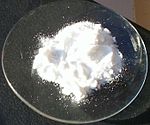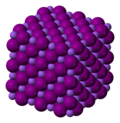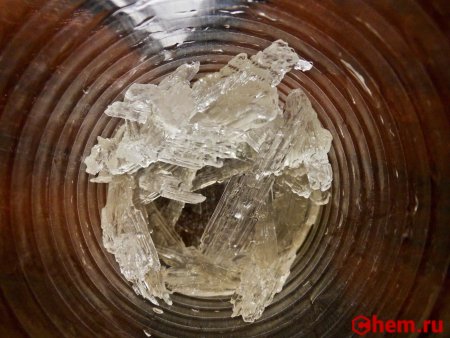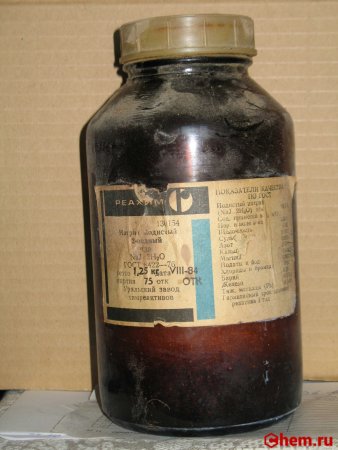| Иодид натрия | |
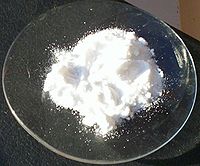 |
|
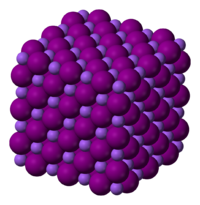 |
|
| Общие | |
|---|---|
| Химическая формула | NaI |
| Физические свойства | |
| Состояние (ст. усл.) | кристаллическое вещество |
| Молярная масса | 149,89424 г/моль |
| Плотность | 3,67 г/см³ |
| Термические свойства | |
| Температура плавления | 660 °C |
| Температура кипения | 1304 °C |
| Классификация | |
| Рег. номер CAS | 7681-82-5 |
Иоди́д на́трия, иодистый натрий, NaI — натриевая соль иодоводородной кислоты.
Содержание
- 1 Физические свойства
- 2 Использование
- 2.1 Химический синтез
- 2.2 Ядерная физика
- 3 Растворимость
- 4 Литература
- 5 См. также
- 6 Примечания
Физические свойства
При нормальных условиях — белый гигроскопичный порошок или прозрачный бесцветный кристалл. Солёный на вкус. Запаха не имеет. На воздухе сыреет с разложением и выделением йода. Легко растворим в воде, в спирте, в глицерине.
Использование
Химический синтез
Иодид натрия используется в полимеразной цепной реакции и в реакции Финкельштейна (раствор в ацетоне) для превращения хлоралкилов в иодалкилы:
Ядерная физика
Кристаллы иодида натрия, для улучшения световыхода активированного таллием, NaI(Tl), применяются при изготовлении сцинтилляционных детекторов элементарных частиц, прежде всего в калориметрах. Иодид натрия гигроскопичен, поэтому такие детекторы нуждаются в герметичной упаковке, предотвращающей контакт с влагой воздуха. NaI(Tl) — один из самых распространённых сцинтилляторов, что объясняется его высоким световыходом, достаточно коротким временем высвечивания (около микросекунды) и высоким эффективным зарядом ядра (следовательно, высокой эффективностью поглощения гамма-квантов).
Растворимость
| H2O | 184 |
| Жидкий аммиак | 162 |
| Жидкий диоксид серы | 15 |
| Метанол | 62.5 — 83.0 |
| Муравьиная кислота | 61.8 |
| Ацетонитрил | 24.9 |
| Ацетон | 28.0 |
| Формамид | 57 — 85 |
| Ацетамид | 32.3 |
| Диметилформамид | 3.7 — 6.4 |
| [1] |
Литература
- Кнунянц И. Л. и др. т.3 Мед-Пол // Химическая энциклопедия. — М.: Большая Российская Энциклопедия, 1992. — 639 с. — 50 000 экз. — ISBN 5-85270-039-8
См. также
- Тератология
Примечания
- ↑ Burgess, J. «Metal Ions in Solution» (Ellis Horwood, New York, 1978) ISBN 0-85312-027-7
|
Растворимость кислот, оснований и солей в воде |
||||||||||||||||||||||||||||||||||||||||||||||||||||||||||||||||||||||||||||||||||||||||||||||||||||||||||||||||||||||||||||||||||||||||||||||||||||||||||||||||||||||||||||||||||||||||||||||||||||||||||||||||||||||||||||||||||||||||||||||||||||||||||||||||||||||||||||||||||||||||||||||||||||||||||||||||||||||||||||||||||||||||||||||||||||||||||||||||||||||||||||||||||||||||||||||||||||||||||||||||
|---|---|---|---|---|---|---|---|---|---|---|---|---|---|---|---|---|---|---|---|---|---|---|---|---|---|---|---|---|---|---|---|---|---|---|---|---|---|---|---|---|---|---|---|---|---|---|---|---|---|---|---|---|---|---|---|---|---|---|---|---|---|---|---|---|---|---|---|---|---|---|---|---|---|---|---|---|---|---|---|---|---|---|---|---|---|---|---|---|---|---|---|---|---|---|---|---|---|---|---|---|---|---|---|---|---|---|---|---|---|---|---|---|---|---|---|---|---|---|---|---|---|---|---|---|---|---|---|---|---|---|---|---|---|---|---|---|---|---|---|---|---|---|---|---|---|---|---|---|---|---|---|---|---|---|---|---|---|---|---|---|---|---|---|---|---|---|---|---|---|---|---|---|---|---|---|---|---|---|---|---|---|---|---|---|---|---|---|---|---|---|---|---|---|---|---|---|---|---|---|---|---|---|---|---|---|---|---|---|---|---|---|---|---|---|---|---|---|---|---|---|---|---|---|---|---|---|---|---|---|---|---|---|---|---|---|---|---|---|---|---|---|---|---|---|---|---|---|---|---|---|---|---|---|---|---|---|---|---|---|---|---|---|---|---|---|---|---|---|---|---|---|---|---|---|---|---|---|---|---|---|---|---|---|---|---|---|---|---|---|---|---|---|---|---|---|---|---|---|---|---|---|---|---|---|---|---|---|---|---|---|---|---|---|---|---|---|---|---|---|---|---|---|---|---|---|---|---|---|---|---|---|---|---|---|---|---|---|---|---|---|---|---|---|---|---|---|---|---|---|---|---|---|---|---|---|---|---|---|---|---|---|---|---|---|---|---|---|---|---|---|---|---|---|---|---|---|---|---|---|---|---|---|---|---|---|---|---|---|---|---|---|---|---|---|---|---|---|---|---|---|
|
|
Соединения натрия |
|---|
|
Азид натрия (NaN3) • Альгинат натрия • Алюминат натрия (NaAlO2) • Амид натрия (NaNH2) • Арсенат натрия (Na3AsO4) • Бензилнатрий (NaCH2C6H5) • Бензоат натрия (NaC6H5CO2) • Борогидрид натрия (NaBH4) • Бромат натрия (NaBrO3) • Бромид натрия (NaBr) • Висмутат натрия (NaBiO3) • Вольфрамат натрия (Na2WO4) • Гексагидроксостаннат(IV) натрия (Na2[Sn(OH)6]) • Гексагидроксохромат (III) натрия (Na3[Сr(OH)6]) • Гексанитрокобальтат(III) натрия (Na3[Co(NO2)6]) • Гексафтороалюминат натрия (Na3[AlF6]) • Гексафторосиликат натрия (Na2[SiF6]) • Гексафторостибат натрия (Na[SbF6]) • Гексафторофосфат(V) натрия (Na[PF6]) • Гексахлороиридат(III) натрия (Na3[IrCl6]) • Гексахлорородат(III) натрия (Na3[RhCl6]) • Германат натрия (Na2GeO3) • Гидрид натрия (NaH) • Гидрокарбонат натрия (NaHCO3) • Гидроксид натрия (NaOH) • Гидросульфат натрия (NaHSO4) • Гидросульфид натрия (NaHS) • Гидросульфит натрия (NaHSO3) • Гидрофосфат натрия (Na2HPO4) • Гипонитрит натрия (Na2N2O2) • Гипофосфит натрия (Na(PH2O2)) • Гипохлорит натрия (NaOCl) • Глутамат натрия (C5H8NNaO4) • Дигидропирофосфат натрия (Na2H2P2O7) • Дигидроортопериодат натрия (Na3H2IO6) • Дигидрофосфат натрия (NaH2PO4) • Диоксоферрат(III) натрия (NaFeO2) • Дитионат натрия (Na2S2O6) • Дитионит натрия (Na2S2O4) • Дихромат натрия (Na2Cr2O7) • Диэтилдитиокарбамат натрия (C5H10NS2Na) • Инозинат натрия (C10H11N2Na2O8P) • Иодат натрия (NaIO3) • Иодид натрия (NaI) • Карбонат натрия (Na2CO3) • Лаурилсульфат натрия (C12H25SO4Na) • Метаарсенит натрия (NaAsO2) • Метаборат натрия (NaBO2) • Метаванадат натрия (NaVO3) • Метадисульфит натрия (Na2S2O5) • Метасиликат натрия (Na2SiO3) • Метафосфат натрия (NaPO3) • Надпероксид натрия (NaO2) • Нитрат натрия (NaNO3) • Нитрид натрия (Na3N) • Нитрит натрия (NaNO2) • Нонагидридоренат(VII) натрия (Na2[ReH9]) • Оксид натрия (Na2O) • Ортованадат натрия (Na3VO4) • Ортосиликат натрия (Na4SiO4) • Ортотеллурат натрия (Na6TeO6) • Ортофосфат натрия (Na3PO4) • Пентаборат натрия (NaB5O8) • Периодат натрия (NaIO4) • Перманганат натрия (NaMnO4) • Пероксид натрия (Na2O2) • Перосмат натрия (Na2[OsO2(OH)4]) • Пиросульфат натрия (Na2S2O7) • Пирофосфат натрия (Na4P2O7) • Полисульфид натрия (Na2Sn) • Сегнетова соль (KNaC4H4O6•4H2O) • Селенат натрия (Na2SeO4) • Селенид натрия (Na2Se) • Селенит натрия (Na2SeO3) • Тиоантимонат натрия (Na3[SbS4]•9H2O) • Сульфат натрия (Na2SO4) • Сульфид натрия (Na2S) • Сульфит натрия (Na2SO3) • Тартрат натрия (Na2C4H4O6) • Теллурит натрия (Na2TeO3) • Теллурид натрия (Na2Te) • Тетраборат натрия (Na2B4O7) • Тетрагидроксоцинкат(II) натрия (Na2[Zn(OH)4]) • Тетраоксоманганат(V) натрия (Na3MnO4) • Тетратиоарсенат натрия (Na3[AsS4]) • Тиосульфат натрия (Na2S2O3) • Тиоцианат натрия (NaSCN) • Тритиостибат натрия (Na3[SbS3]) • Трифосфат натрия (Na5P3O10) • Фенилнатрий (NaC6H5) • Формиат натрия (HCOONa) • Фосфид натрия (Na3P) • Фосфит натрия (Na2(PHO2)) • Фторид натрия (NaF) • Хлорид натрия (NaCl) • Хлорат натрия (NaClO3) • Хлорит натрия (NaClO2) • Цианат натрия (NaNCO) • Этилнатрий (NaC2H5) |
From Wikipedia, the free encyclopedia
(Redirected from Sodium Iodide)
|
||
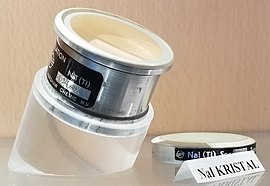
NaI(Tl) scintillators |
||
| Identifiers | ||
|---|---|---|
|
CAS Number |
|
|
|
3D model (JSmol) |
|
|
| ChEBI |
|
|
| ChEMBL |
|
|
| ChemSpider |
|
|
| ECHA InfoCard | 100.028.800 |
|
|
PubChem CID |
|
|
| RTECS number |
|
|
| UNII |
|
|
|
CompTox Dashboard (EPA) |
|
|
|
InChI
|
||
|
SMILES
|
||
| Properties | ||
|
Chemical formula |
NaI | |
| Molar mass | 149.894[1] | |
| Appearance | white solid deliquescent[1] |
|
| Odor | odorless | |
| Density | 3.67 g cm−3[1] | |
| Melting point | 661 °C (1,222 °F; 934 K)[1] | |
| Boiling point | 1,304 °C (2,379 °F; 1,577 K)[1] | |
|
Solubility in water |
1587 g/L (0 °C) 1842 g/L (25 °C) 2278 g/L (50 °C) 2940 g/L (70 °C) 3020 g/L (100 °C)[2][3] |
|
| Solubility | ethanol, acetone[1] | |
| Band gap | 5.89 eV[4][5] | |
|
Magnetic susceptibility (χ) |
−57×10−6 cm3 mol−1[6] | |
|
Refractive index (nD) |
1.93 (300 nm) 1.774 (589 nm) 1.71 (10 μm)[7] |
|
| Structure[8] | ||
|
Crystal structure |
Halite, cF8 | |
|
Space group |
Fm3m, No. 225 | |
|
Lattice constant |
a = 0.6462 nm |
|
|
Formula units (Z) |
4 | |
|
Coordination geometry |
Octahedral | |
| Thermochemistry[9] | ||
|
Heat capacity (C) |
52.1 J mol−1 K−1 | |
|
Std molar |
98.5 J mol−1 K−1 | |
|
Std enthalpy of |
−287.8 kJ mol−1 | |
|
Gibbs free energy (ΔfG⦵) |
−286.1 kJ mol−1 | |
| Hazards | ||
| Occupational safety and health (OHS/OSH): | ||
|
Main hazards |
Irritant, can harm the unborn child | |
| GHS labelling: | ||
|
Pictograms |
 
|
|
|
Signal word |
Danger | |
|
Hazard statements |
H315, H319, H400 | |
|
Precautionary statements |
P273, P305+P351+P338[10] | |
| NFPA 704 (fire diamond) |
1 0 1 |
|
| Flash point | Non-flammable | |
| Safety data sheet (SDS) | [1] | |
| Related compounds | ||
|
Other anions |
Sodium fluoride Sodium chloride Sodium bromide Sodium astatide |
|
|
Other cations |
Lithium iodide Potassium iodide Rubidium iodide Caesium iodide Francium iodide |
|
|
Except where otherwise noted, data are given for materials in their standard state (at 25 °C [77 °F], 100 kPa).
Infobox references |
Sodium iodide (chemical formula NaI) is an ionic compound formed from the chemical reaction of sodium metal and iodine. Under standard conditions, it is a white, water-soluble solid comprising a 1:1 mix of sodium cations (Na+) and iodide anions (I−) in a crystal lattice. It is used mainly as a nutritional supplement and in organic chemistry. It is produced industrially as the salt formed when acidic iodides react with sodium hydroxide.[11] It is a chaotropic salt.
Uses[edit]
Food supplement[edit]
Sodium iodide, as well as potassium iodide, is commonly used to treat and prevent iodine deficiency. Iodized table salt contains 10 ppm iodide.[11]
Organic synthesis[edit]
Sodium iodide is used for conversion of alkyl chlorides into alkyl iodides. This method, the Finkelstein reaction,[13] relies on the insolubility of sodium chloride in acetone to drive the reaction:[14]
-
- R–Cl + NaI → R–I + NaCl
Nuclear medicine[edit]
Some radioactive iodide salts of sodium, including Na125I and Na131I, have radiopharmaceuticalf thyroid cancer and hyperthyroidism or as radioactive tracer in imaging (see Isotopes of iodine > Radioiodines I-123, I-124, I-125, and I-131 in medicine and biology).
Thallium-doped NaI(Tl) scintillators[edit]
Sodium iodide activated with thallium, NaI(Tl), when subjected to ionizing radiation, emits photons (i.e., scintillate) and is used in scintillation detectors, traditionally in nuclear medicine, geophysics, nuclear physics, and environmental measurements. NaI(Tl) is the most widely used scintillation material. The crystals are usually coupled with a photomultiplier tube, in a hermetically sealed assembly, as sodium iodide is hygroscopic. Fine-tuning of some parameters (i.e., radiation hardness, afterglow, transparency) can be achieved by varying the conditions of the crystal growth. Crystals with a higher level of doping are used in X-ray detectors with high spectrometric quality. Sodium iodide can be used both as single crystals and as polycrystals for this purpose. The wavelength of maximum emission is 415 nm.[15]
Radiocontrast[edit]
António Egas Moniz searched for a radiocontrast agent for cerebral angiography.[16] After experiments on rabbits and dogs he settled upon sodium iodide as the best medium.[16]
Solubility data[edit]
Sodium iodide exhibits high solubility in some organic solvents, unlike sodium chloride or even bromide:
| Solvent | Solubility of NaI (g NaI/kg of solvent at 25 °C)[17] |
|---|---|
| H2O | 1842 |
| Liquid ammonia | 1620 |
| Liquid sulfur dioxide | 150 |
| Methanol | 625–830 |
| Formic acid | 618 |
| Acetonitrile | 249 |
| Acetone | 504 |
| Formamide | 570–850 |
| Acetamide | 323 (41.5 °C) |
| Dimethylformamide | 37–64 |
| Dichloromethane | 0.09[18] |
Stability[edit]
Iodides (including sodium iodide) are detectably oxidized by atmospheric oxygen (O2) to molecular iodine (I2). I2 and I− complex to form the triiodide complex, which has a yellow color, unlike the white color of sodium iodide. Water accelerates the oxidation process, and iodide can also produce I2 by photooxidation, therefore for maximum stability sodium iodide should be stored under dark, low temperature, low humidity conditions.
See also[edit]
- Gamma spectroscopy
- Scintillation counter
- Teratology
References[edit]
- ^ a b c d e f Haynes, p. 4.86
- ^ Seidell, Atherton (1919). Solubilities of inorganic and organic compounds c. 2. D. Van Nostrand Company. p. 655.
- ^ Haynes, p. 5.171
- ^ Miyata, Takeo (1969). «Exciton Structure of NaI and NaBr». Journal of the Physical Society of Japan. 27 (1): 266. Bibcode:1969JPSJ…27..266M. doi:10.1143/JPSJ.27.266.
- ^ Guizzetti, G.; Nosenzo, L.; Reguzzoni, E. (1977). «Optical properties and electronic structure of alkali halides by thermoreflectivity». Physical Review B. 15 (12): 5921–5926. Bibcode:1977PhRvB..15.5921G. doi:10.1103/PhysRevB.15.5921.
- ^ Haynes, p. 4.130
- ^ Haynes, p. 10.250
- ^ Davey, Wheeler P. (1923). «Precision Measurements of Crystals of the Alkali Halides». Physical Review. 21 (2): 143–161. Bibcode:1923PhRv…21..143D. doi:10.1103/PhysRev.21.143.
- ^ Haynes, p. 5.36
- ^ «Sodium iodide 383112». Sigma Aldrich.
- ^ a b Lyday, Phyllis A. (2005). «Iodine and Iodine Compounds». Ullmann’s Encyclopedia of Industrial Chemistry. Weinheim: Wiley-VCH. pp. 382–390. doi:10.1002/14356007.a14_381.
- ^ Senga, Ryosuke; Suenaga, Kazu (2015). «Single-atom electron energy loss spectroscopy of light elements». Nature Communications. 6: 7943. Bibcode:2015NatCo…6.7943S. doi:10.1038/ncomms8943. PMC 4532884. PMID 26228378.
- ^ Finkelstein, Hank (1910). «Darstellung organischer Jodide aus den entsprechenden Bromiden und Chloriden». Ber. Dtsch. Chem. Ges. (in German). 43 (2): 1528–1532. doi:10.1002/cber.19100430257.
- ^ Streitwieser, Andrew (1956). «Solvolytic Displacement Reactions At Saturated Carbon Atoms». Chemical Reviews. 56 (4): 571–752. doi:10.1021/cr50010a001.
- ^ «Scintillation Materials and Assemblies» (PDF). Saint-Gobain Crystals. 2016. Retrieved June 21, 2017.
- ^ a b «Antonio Egas Moniz (1874-1955) Portuguese Neurologist». JAMA: The Journal of the American Medical Association. American Medical Association (AMA). 206 (2): 368. 1968. doi:10.1001/jama.1968.03150020084021. ISSN 0098-7484.
- ^ Burgess, John (1978). Metal Ions in Solution. Ellis Horwood Series in Chemical Sciences. New York: Ellis Horwood. ISBN 9780470262931.
- ^ De Namor, Angela F. Danil; Traboulssi, Rafic; Salazar, Franz Fernández; De Acosta, Vilma Dianderas; De Vizcardo, Yboni Fernández; Portugal, Jaime Munoz (1989). «Transfer and partition free energies of 1:1 electrolytes in the water–dichloromethane solvent system at 298.15 K». Journal of the Chemical Society, Faraday Transactions 1. 85 (9): 2705–2712. doi:10.1039/F19898502705.
Cited sources[edit]
- Haynes, William M., ed. (2016). CRC Handbook of Chemistry and Physics (97th ed.). CRC Press. p. 4.49. ISBN 9781498754293.
External links[edit]
- «ICSC 1009 – Sodium Iodide (Anhydrous)». International Chemical Safety Card. April 20, 2005. Retrieved June 21, 2017.
- «Material Safety Data Sheet (MSDS) – Safety data for sodium iodide». ScienceLab.com. May 21, 2013. Retrieved June 21, 2017.
- «Sodium iodide (Oral route, Injection route, Intravenous route)». Drugs.com. 2017. Retrieved June 21, 2017.
- «Safety Data Sheet – Sodium iodide» (PDF). Global Safety Management. January 23, 2015. Retrieved October 16, 2019.
From Wikipedia, the free encyclopedia
(Redirected from Sodium Iodide)
|
||

NaI(Tl) scintillators |
||
| Identifiers | ||
|---|---|---|
|
CAS Number |
|
|
|
3D model (JSmol) |
|
|
| ChEBI |
|
|
| ChEMBL |
|
|
| ChemSpider |
|
|
| ECHA InfoCard | 100.028.800 |
|
|
PubChem CID |
|
|
| RTECS number |
|
|
| UNII |
|
|
|
CompTox Dashboard (EPA) |
|
|
|
InChI
|
||
|
SMILES
|
||
| Properties | ||
|
Chemical formula |
NaI | |
| Molar mass | 149.894[1] | |
| Appearance | white solid deliquescent[1] |
|
| Odor | odorless | |
| Density | 3.67 g cm−3[1] | |
| Melting point | 661 °C (1,222 °F; 934 K)[1] | |
| Boiling point | 1,304 °C (2,379 °F; 1,577 K)[1] | |
|
Solubility in water |
1587 g/L (0 °C) 1842 g/L (25 °C) 2278 g/L (50 °C) 2940 g/L (70 °C) 3020 g/L (100 °C)[2][3] |
|
| Solubility | ethanol, acetone[1] | |
| Band gap | 5.89 eV[4][5] | |
|
Magnetic susceptibility (χ) |
−57×10−6 cm3 mol−1[6] | |
|
Refractive index (nD) |
1.93 (300 nm) 1.774 (589 nm) 1.71 (10 μm)[7] |
|
| Structure[8] | ||
|
Crystal structure |
Halite, cF8 | |
|
Space group |
Fm3m, No. 225 | |
|
Lattice constant |
a = 0.6462 nm |
|
|
Formula units (Z) |
4 | |
|
Coordination geometry |
Octahedral | |
| Thermochemistry[9] | ||
|
Heat capacity (C) |
52.1 J mol−1 K−1 | |
|
Std molar |
98.5 J mol−1 K−1 | |
|
Std enthalpy of |
−287.8 kJ mol−1 | |
|
Gibbs free energy (ΔfG⦵) |
−286.1 kJ mol−1 | |
| Hazards | ||
| Occupational safety and health (OHS/OSH): | ||
|
Main hazards |
Irritant, can harm the unborn child | |
| GHS labelling: | ||
|
Pictograms |
 
|
|
|
Signal word |
Danger | |
|
Hazard statements |
H315, H319, H400 | |
|
Precautionary statements |
P273, P305+P351+P338[10] | |
| NFPA 704 (fire diamond) |
1 0 1 |
|
| Flash point | Non-flammable | |
| Safety data sheet (SDS) | [1] | |
| Related compounds | ||
|
Other anions |
Sodium fluoride Sodium chloride Sodium bromide Sodium astatide |
|
|
Other cations |
Lithium iodide Potassium iodide Rubidium iodide Caesium iodide Francium iodide |
|
|
Except where otherwise noted, data are given for materials in their standard state (at 25 °C [77 °F], 100 kPa).
Infobox references |
Sodium iodide (chemical formula NaI) is an ionic compound formed from the chemical reaction of sodium metal and iodine. Under standard conditions, it is a white, water-soluble solid comprising a 1:1 mix of sodium cations (Na+) and iodide anions (I−) in a crystal lattice. It is used mainly as a nutritional supplement and in organic chemistry. It is produced industrially as the salt formed when acidic iodides react with sodium hydroxide.[11] It is a chaotropic salt.
Uses[edit]
Food supplement[edit]
Sodium iodide, as well as potassium iodide, is commonly used to treat and prevent iodine deficiency. Iodized table salt contains 10 ppm iodide.[11]
Organic synthesis[edit]
Sodium iodide is used for conversion of alkyl chlorides into alkyl iodides. This method, the Finkelstein reaction,[13] relies on the insolubility of sodium chloride in acetone to drive the reaction:[14]
-
- R–Cl + NaI → R–I + NaCl
Nuclear medicine[edit]
Some radioactive iodide salts of sodium, including Na125I and Na131I, have radiopharmaceuticalf thyroid cancer and hyperthyroidism or as radioactive tracer in imaging (see Isotopes of iodine > Radioiodines I-123, I-124, I-125, and I-131 in medicine and biology).
Thallium-doped NaI(Tl) scintillators[edit]
Sodium iodide activated with thallium, NaI(Tl), when subjected to ionizing radiation, emits photons (i.e., scintillate) and is used in scintillation detectors, traditionally in nuclear medicine, geophysics, nuclear physics, and environmental measurements. NaI(Tl) is the most widely used scintillation material. The crystals are usually coupled with a photomultiplier tube, in a hermetically sealed assembly, as sodium iodide is hygroscopic. Fine-tuning of some parameters (i.e., radiation hardness, afterglow, transparency) can be achieved by varying the conditions of the crystal growth. Crystals with a higher level of doping are used in X-ray detectors with high spectrometric quality. Sodium iodide can be used both as single crystals and as polycrystals for this purpose. The wavelength of maximum emission is 415 nm.[15]
Radiocontrast[edit]
António Egas Moniz searched for a radiocontrast agent for cerebral angiography.[16] After experiments on rabbits and dogs he settled upon sodium iodide as the best medium.[16]
Solubility data[edit]
Sodium iodide exhibits high solubility in some organic solvents, unlike sodium chloride or even bromide:
| Solvent | Solubility of NaI (g NaI/kg of solvent at 25 °C)[17] |
|---|---|
| H2O | 1842 |
| Liquid ammonia | 1620 |
| Liquid sulfur dioxide | 150 |
| Methanol | 625–830 |
| Formic acid | 618 |
| Acetonitrile | 249 |
| Acetone | 504 |
| Formamide | 570–850 |
| Acetamide | 323 (41.5 °C) |
| Dimethylformamide | 37–64 |
| Dichloromethane | 0.09[18] |
Stability[edit]
Iodides (including sodium iodide) are detectably oxidized by atmospheric oxygen (O2) to molecular iodine (I2). I2 and I− complex to form the triiodide complex, which has a yellow color, unlike the white color of sodium iodide. Water accelerates the oxidation process, and iodide can also produce I2 by photooxidation, therefore for maximum stability sodium iodide should be stored under dark, low temperature, low humidity conditions.
See also[edit]
- Gamma spectroscopy
- Scintillation counter
- Teratology
References[edit]
- ^ a b c d e f Haynes, p. 4.86
- ^ Seidell, Atherton (1919). Solubilities of inorganic and organic compounds c. 2. D. Van Nostrand Company. p. 655.
- ^ Haynes, p. 5.171
- ^ Miyata, Takeo (1969). «Exciton Structure of NaI and NaBr». Journal of the Physical Society of Japan. 27 (1): 266. Bibcode:1969JPSJ…27..266M. doi:10.1143/JPSJ.27.266.
- ^ Guizzetti, G.; Nosenzo, L.; Reguzzoni, E. (1977). «Optical properties and electronic structure of alkali halides by thermoreflectivity». Physical Review B. 15 (12): 5921–5926. Bibcode:1977PhRvB..15.5921G. doi:10.1103/PhysRevB.15.5921.
- ^ Haynes, p. 4.130
- ^ Haynes, p. 10.250
- ^ Davey, Wheeler P. (1923). «Precision Measurements of Crystals of the Alkali Halides». Physical Review. 21 (2): 143–161. Bibcode:1923PhRv…21..143D. doi:10.1103/PhysRev.21.143.
- ^ Haynes, p. 5.36
- ^ «Sodium iodide 383112». Sigma Aldrich.
- ^ a b Lyday, Phyllis A. (2005). «Iodine and Iodine Compounds». Ullmann’s Encyclopedia of Industrial Chemistry. Weinheim: Wiley-VCH. pp. 382–390. doi:10.1002/14356007.a14_381.
- ^ Senga, Ryosuke; Suenaga, Kazu (2015). «Single-atom electron energy loss spectroscopy of light elements». Nature Communications. 6: 7943. Bibcode:2015NatCo…6.7943S. doi:10.1038/ncomms8943. PMC 4532884. PMID 26228378.
- ^ Finkelstein, Hank (1910). «Darstellung organischer Jodide aus den entsprechenden Bromiden und Chloriden». Ber. Dtsch. Chem. Ges. (in German). 43 (2): 1528–1532. doi:10.1002/cber.19100430257.
- ^ Streitwieser, Andrew (1956). «Solvolytic Displacement Reactions At Saturated Carbon Atoms». Chemical Reviews. 56 (4): 571–752. doi:10.1021/cr50010a001.
- ^ «Scintillation Materials and Assemblies» (PDF). Saint-Gobain Crystals. 2016. Retrieved June 21, 2017.
- ^ a b «Antonio Egas Moniz (1874-1955) Portuguese Neurologist». JAMA: The Journal of the American Medical Association. American Medical Association (AMA). 206 (2): 368. 1968. doi:10.1001/jama.1968.03150020084021. ISSN 0098-7484.
- ^ Burgess, John (1978). Metal Ions in Solution. Ellis Horwood Series in Chemical Sciences. New York: Ellis Horwood. ISBN 9780470262931.
- ^ De Namor, Angela F. Danil; Traboulssi, Rafic; Salazar, Franz Fernández; De Acosta, Vilma Dianderas; De Vizcardo, Yboni Fernández; Portugal, Jaime Munoz (1989). «Transfer and partition free energies of 1:1 electrolytes in the water–dichloromethane solvent system at 298.15 K». Journal of the Chemical Society, Faraday Transactions 1. 85 (9): 2705–2712. doi:10.1039/F19898502705.
Cited sources[edit]
- Haynes, William M., ed. (2016). CRC Handbook of Chemistry and Physics (97th ed.). CRC Press. p. 4.49. ISBN 9781498754293.
External links[edit]
- «ICSC 1009 – Sodium Iodide (Anhydrous)». International Chemical Safety Card. April 20, 2005. Retrieved June 21, 2017.
- «Material Safety Data Sheet (MSDS) – Safety data for sodium iodide». ScienceLab.com. May 21, 2013. Retrieved June 21, 2017.
- «Sodium iodide (Oral route, Injection route, Intravenous route)». Drugs.com. 2017. Retrieved June 21, 2017.
- «Safety Data Sheet – Sodium iodide» (PDF). Global Safety Management. January 23, 2015. Retrieved October 16, 2019.
Физические свойства
Йодид натрия NaI — соль щелочного металла натрия и йодоводородной кислоты. Белый, при хранении на свету желтеет из-за окисления. Плавится без разложения, при дальнейшем нагревании разлагается. Хорошо растворяется в воде (гидролиза нет).
Относительная молекулярная масса Mr = 149,90; относительная плотность для тв. и ж. состояния d = 3,667; tпл = 661º C;
Способ получения
1. Йодид натрия можно получить путем взаимодействия горячего гидроксида натрия, пероксида водорода и йода, образуются йодид натрия, газ кислород и вода:
2NaOH + I2 + H2O2 = 2NaI + O2↑ + 2H2O,
если гидроксид натрия будет холодным и к нему вместе с йодом добавить газ сероводород, то в результате данной реакции произойдет образование йодида натрия, осадка серы и воды:
2NaOH + I2 + H2S = 2NaI + S↓ + 2H2O
2. При температуре 150–200º C, в результате взаимодействия натрия и йода, образуется йодид натрия:
2Na + I2 = 2NaI
3. Разбавленный раствор гидроксида натрия реагирует с йодидом железа в атмосфере азота. При этом образуются йодид натрия и осадок гидроксид железа:
2NaOH + FeI2 = 2NaI + Fe(OH)2↓
Качественная реакция
Качественная реакция на йодид натрия — взаимодействие его с нитратом серебра, в результате реакции происходит образование осадка желтого цвета:
1. При взаимодействии с нитратом серебра, йодид натрия образует нитрат натрия и осадок йодид серебра:
NaI + AgNO3 = NaNO3 + AgI↓
Химические свойства
1. Йодид натрия разлагается при температуре выше 1400º C с образованием натрия и йода:
2NaI = 2Na + I2
2. Йодид натрия вступает в реакцию с простыми веществами:
2.1. Холодный йодид натрия взаимодействует с хлором. В результате реакции происходит образование хлорида натрия и осадка йода:
2NaI + Cl2 = 2NaCl + I2↓
2.2. Холодный йодид натрия взаимодействует с бромом. В результате реакции происходит образование бромида натрия и осадка йода:
2NaI + Br2 = 2NaBr + I2↓
3. Йодид натрия способен вступать в реакцию со сложными веществами:
3.1. Йодид натрия реагирует с кислотами-окислителями:
3.1.1. Твердый йодид натрия реагирует с серной кислотой при 30 — 50º С. Взаимодействие данных веществ приводит к образованию осадка йода, газа сероводорода, воды и гидросульфата натрия:
8NaI + 9H2SO4 = 4I2↓ + H2S↑ + 4H2O + 8NaHSO4
3.1.2. При кипении, в результате взаимодействия твердого йодида натрия и концентрированной азотной кислоты образуются осадок йод, газ оксид азота (IV), вода и нитрат натрия:
2NaI + 4HNO3 = I2↓ + 2NO2↑ + 2H2O + 2NaNO3
4. Йодид натрия способен вступать в реакцию с соединениями железа (III):
NaI + FeCl3 = FeCl2 + I2↓ + NaCl
Being one of the two elements of our table salt is our biggest claim to fame. Sodium combines with chlorine (Cl) to form sodium chloride (NaCl). Sodium is a reactive, soft metal with a low melting point and is commercially the most important of all alkali metals. Sodium reacts with hydrogen at temperatures above 200 ºC to form sodium hydride. It also reacts with various metal halides to form sodium chloride and metals. With atomic number 11, it is represented by the symbol Na on the periodic table.
Iodide is a salt or ester of the mineral iodine. Iodine salts are weak reducing agents, many react with oxygen to form iodine. NCI Thesaurus (NCIt) Iodide is a halide anion and monoatomic iodine. It acts as a human metabolite.
What is Sodium Iodide?
Sodium iodide is an ionic compound formed by the chemical reaction of metal sodium and iodine. In standard conditions, it is a white and solid containing a 1:1 mixture (Na+) of a sodium cation (Na+) and a 1:1 mixture of iodide anion (I–).
It is mainly used in food additives and organic chemistry. The acid iodide is industrially manufactured as a salt formed when reacting with sodium hydroxide. This is Chaotropic Salt.
Sodium Iodide Formula
Sodium iodide is an inorganic salt of the formula NaI. It is an important source of iodine. In industry, sodium iodide is produced by the reaction of hydroiodic acid or iodine with sodium hydroxide.
NaOH + HI → NaI + H2O
Structure of Sodium Iodide
Sodium iodide has a chemical formula of NaI and a molar mass of 149.89 g/mol. It is a simple ionic compound composed of a sodium cation (Na+) and an iodide anion (I). Solid NaI has the same octahedral crystal geometry as sodium chloride (NaCl). Its chemical structure is:
Preparation of Sodium Iodide
Sodium iodide is produced commercially by the reaction of sodium hydroxide with iodine or hydroiodic acid. It can also be obtained by treating sodium carbonate with a solution of hydroiodic acid.
NaOH + HI → NaI + H2O
Physical Properties of Sodium Iodide
The Physical Properties of Sodium Iodide are,
- The melting point of sodium iodide is 661 degrees Celsius.
- Sodium iodide has a boiling point of 1304 degrees Celsius.
- A highly deliquescent substance that absorbs moisture and turns into a solution.
- White crystals or odorless powder.
Chemical Properties of Sodium Iodide
Sodium iodide is very dissolved in water to have an ion structure of a lattice of an ionic crystal grid. Iodide is not only rusted in water, but also in the other natural solvents, but it depends on air, moisture, and lung, and the strong northern solid is brown into the introduction of air. This creates iodine by responding to various oxidizers, solid acids, and bromine trifle explosions.
The iodide is oxidized by oxygen (O2) to the long gas (I2). The generated I2 and I-complex form a yellow triiodide composite that is ultimately a yellowish color, in contrast to the white shade of iodine sodium. Water accelerates the oxidation process and iodide can also form I2 gas by simple photooxidation. This is one of the main reasons why sodium iodide should be stored in low light, low temperature, and low humidity conditions. It is recommended to take precautions and keep solids away from external elements.
NaI + Cl2 → NaCl + I2
NaI + 4H2O → [Na(H2O)4]+ + I
Hot sodium also reacts with halogen elements such as bromine or iodine vapor to form sodium bromide or sodium iodide. Each typical reaction leading to the formation of sodium iodide produces an orange flame and a white solid ion lattice. Iodide is negatively charged, meaning it contains an extra electron that acts as a valence. When another iodine atom can be gained, it can lose electrons to form the stable gas I2. The lost electrons are recovered by other dependent atoms or molecules, making iodine a good reducing agent.
Uses of Sodium Iodide
- Sodium iodide is regularly used as a dietary iodine supplement and, like table salt (NaCl), is used to produce pure NaCl. This disease can negatively affect the endocrine system. However, NaI is a source of iodine and may help relieve symptoms.
- Sodium Iodide is also used as a reagent in chemical combinations to produce various alkyl iodides for various purposes.
- This halide salt is used medically as an indicator and detector in medical devices such as CT scans and PET scans.
- Sodium Iodide is used in medicine as an iodine supplement for the treatment of thyroid disorders.
- Used to treat actinomycosis and actinomycosis in cattle.
Sample Questions
Question 1: What is the chemical formula of salt?
Answer:
To most people, salt refers to table salt, which is sodium chloride. Sodium chloride forms from the ionic bonding of sodium ions and chloride ions. There is one sodium cation (Na+) for every chloride anion (Cl–), so the chemical formula is NaCl.
Question 2: What is iodine made of?
Answer:
Now the main sources of iodine are iodate minerals, natural brine deposits left by the evaporation of ancient seas, and brackish (briny) waters from oil and salt wells. Iodine is obtained commercially by releasing iodine from the iodate obtained from nitrate ores or extracting iodine vapor from the processed brine.
Question 3: Why is sodium iodide soluble in water?
Answer:
NaI is an ionic compound that can dissolve in water due to the polar nature of water molecules. Iodine is made up of molecules of I2, which individually have no dipole moment (the I-I bond has no dipole as both iodine atoms have the same electronegativity).
Question 4: How does sodium iodide dissolve?
Answer:
A compound dissolves in water whenever solvation energy (hydration energy in this case) is greater than lattice energy. Lattice energy is the energy required to break the lattice. Solvation energy is the energy released when a compound is solvated.
Question 5: Does pink Himalayan salt have iodine?
Answer:
Himalayan salt has no added iodine, which may cause hypoactive thyroid in iodine-deficient individuals. There are no proven health benefits to using Himalayan salt, just like there is no benefit of using Himalayan salt lamps.
Being one of the two elements of our table salt is our biggest claim to fame. Sodium combines with chlorine (Cl) to form sodium chloride (NaCl). Sodium is a reactive, soft metal with a low melting point and is commercially the most important of all alkali metals. Sodium reacts with hydrogen at temperatures above 200 ºC to form sodium hydride. It also reacts with various metal halides to form sodium chloride and metals. With atomic number 11, it is represented by the symbol Na on the periodic table.
Iodide is a salt or ester of the mineral iodine. Iodine salts are weak reducing agents, many react with oxygen to form iodine. NCI Thesaurus (NCIt) Iodide is a halide anion and monoatomic iodine. It acts as a human metabolite.
What is Sodium Iodide?
Sodium iodide is an ionic compound formed by the chemical reaction of metal sodium and iodine. In standard conditions, it is a white and solid containing a 1:1 mixture (Na+) of a sodium cation (Na+) and a 1:1 mixture of iodide anion (I–).
It is mainly used in food additives and organic chemistry. The acid iodide is industrially manufactured as a salt formed when reacting with sodium hydroxide. This is Chaotropic Salt.
Sodium Iodide Formula
Sodium iodide is an inorganic salt of the formula NaI. It is an important source of iodine. In industry, sodium iodide is produced by the reaction of hydroiodic acid or iodine with sodium hydroxide.
NaOH + HI → NaI + H2O
Structure of Sodium Iodide
Sodium iodide has a chemical formula of NaI and a molar mass of 149.89 g/mol. It is a simple ionic compound composed of a sodium cation (Na+) and an iodide anion (I). Solid NaI has the same octahedral crystal geometry as sodium chloride (NaCl). Its chemical structure is:
Preparation of Sodium Iodide
Sodium iodide is produced commercially by the reaction of sodium hydroxide with iodine or hydroiodic acid. It can also be obtained by treating sodium carbonate with a solution of hydroiodic acid.
NaOH + HI → NaI + H2O
Physical Properties of Sodium Iodide
The Physical Properties of Sodium Iodide are,
- The melting point of sodium iodide is 661 degrees Celsius.
- Sodium iodide has a boiling point of 1304 degrees Celsius.
- A highly deliquescent substance that absorbs moisture and turns into a solution.
- White crystals or odorless powder.
Chemical Properties of Sodium Iodide
Sodium iodide is very dissolved in water to have an ion structure of a lattice of an ionic crystal grid. Iodide is not only rusted in water, but also in the other natural solvents, but it depends on air, moisture, and lung, and the strong northern solid is brown into the introduction of air. This creates iodine by responding to various oxidizers, solid acids, and bromine trifle explosions.
The iodide is oxidized by oxygen (O2) to the long gas (I2). The generated I2 and I-complex form a yellow triiodide composite that is ultimately a yellowish color, in contrast to the white shade of iodine sodium. Water accelerates the oxidation process and iodide can also form I2 gas by simple photooxidation. This is one of the main reasons why sodium iodide should be stored in low light, low temperature, and low humidity conditions. It is recommended to take precautions and keep solids away from external elements.
NaI + Cl2 → NaCl + I2
NaI + 4H2O → [Na(H2O)4]+ + I
Hot sodium also reacts with halogen elements such as bromine or iodine vapor to form sodium bromide or sodium iodide. Each typical reaction leading to the formation of sodium iodide produces an orange flame and a white solid ion lattice. Iodide is negatively charged, meaning it contains an extra electron that acts as a valence. When another iodine atom can be gained, it can lose electrons to form the stable gas I2. The lost electrons are recovered by other dependent atoms or molecules, making iodine a good reducing agent.
Uses of Sodium Iodide
- Sodium iodide is regularly used as a dietary iodine supplement and, like table salt (NaCl), is used to produce pure NaCl. This disease can negatively affect the endocrine system. However, NaI is a source of iodine and may help relieve symptoms.
- Sodium Iodide is also used as a reagent in chemical combinations to produce various alkyl iodides for various purposes.
- This halide salt is used medically as an indicator and detector in medical devices such as CT scans and PET scans.
- Sodium Iodide is used in medicine as an iodine supplement for the treatment of thyroid disorders.
- Used to treat actinomycosis and actinomycosis in cattle.
Sample Questions
Question 1: What is the chemical formula of salt?
Answer:
To most people, salt refers to table salt, which is sodium chloride. Sodium chloride forms from the ionic bonding of sodium ions and chloride ions. There is one sodium cation (Na+) for every chloride anion (Cl–), so the chemical formula is NaCl.
Question 2: What is iodine made of?
Answer:
Now the main sources of iodine are iodate minerals, natural brine deposits left by the evaporation of ancient seas, and brackish (briny) waters from oil and salt wells. Iodine is obtained commercially by releasing iodine from the iodate obtained from nitrate ores or extracting iodine vapor from the processed brine.
Question 3: Why is sodium iodide soluble in water?
Answer:
NaI is an ionic compound that can dissolve in water due to the polar nature of water molecules. Iodine is made up of molecules of I2, which individually have no dipole moment (the I-I bond has no dipole as both iodine atoms have the same electronegativity).
Question 4: How does sodium iodide dissolve?
Answer:
A compound dissolves in water whenever solvation energy (hydration energy in this case) is greater than lattice energy. Lattice energy is the energy required to break the lattice. Solvation energy is the energy released when a compound is solvated.
Question 5: Does pink Himalayan salt have iodine?
Answer:
Himalayan salt has no added iodine, which may cause hypoactive thyroid in iodine-deficient individuals. There are no proven health benefits to using Himalayan salt, just like there is no benefit of using Himalayan salt lamps.
| Йодид натрия | |
|---|---|
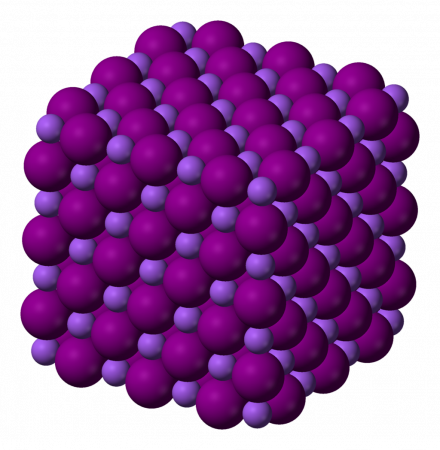 |
|
| Хим. формула | NaI |
| Состояние | кристаллическое вещество |
| Молярная масса | 149,89424 г/моль |
| Плотность | 3,67 г/см³ |
| Температура | |
| • плавления | 660 °C |
| • кипения | 1304 °C |
| Рег. номер CAS | 7681-82-5 |
| PubChem | 5238 |
| Рег. номер EINECS | 231-679-3 |
| SMILES |
[Na+].[I-] |
| InChI |
1S/HI.Na/h1H;/q;+1/p-1 FVAUCKIRQBBSSJ-UHFFFAOYSA-M |
| RTECS | WB6475000 |
| ChEBI | 33167 |
| Номер ООН | 3077 |
| ChemSpider | 5048 |
| ЛД50 | 4340 мг/кг |
| Приведены данные для стандартных условий (25 °C, 100 кПа), если не указано иное. |
Йодид натрия, йодистый натрий, NaI — натриевая соль йодоводородной кислоты.
Содержание
- 1 Физические свойства
- 2 Химические свойства
- 3 Использование
- 3.1 Химический синтез
- 3.2 Ядерная физика
- 3.3 Источники света
- 4 Растворимость
- 5 Токсичность
Кристаллы натрия йодистого
Физические свойства
При нормальных условиях — белый гигроскопичный порошок или прозрачный бесцветный кристалл. Солёный на вкус. Запаха не имеет. На воздухе сыреет с разложением и выделением йода. Легко растворим в воде, в спирте, в глицерине.
Химические свойства
Реагирует со смесью калия перманганата с гидроксидом калия:
- 2NaI + 2KMnO4 + 2 KOH ⟶ I2 + 2K2MnO4 + 2 NaOH
Также взаимодействует со смесью дихромата калия и серной кислоты:
- 6NaI + K2Cr2O7 + 7H2SO4 ⟶ 3I2 + Cr2(SO4)3 + K2SO4 + 3Na2SO4 + 7H2O
Использование
Химический синтез
Йодид натрия используется в полимеразной цепной реакции и в реакции Финкельштейна (раствор в ацетоне) для превращения хлоралкилов в йодалкилы:
-
- RCl + NaI → RI + NaCl
Ядерная физика
Монокристаллы йодида натрия, для улучшения световыхода активированного таллием, NaI(Tl), применяются при изготовлении сцинтилляционных детекторов элементарных частиц, прежде всего в калориметрах для рентгеновской и гамма-спектрометрии в ядерной физике, ядерной медицине, геофизике и т. д. Йодид натрия гигроскопичен, поэтому такие детекторы нуждаются в герметичной упаковке, предотвращающей контакт с влагой воздуха. NaI(Tl) — один из самых распространённых сцинтилляторов, что объясняется его высоким световыходом, хорошим энергетическим разрешением, достаточно коротким временем высвечивания (около микросекунды) и высоким эффективным зарядом ядра (следовательно, высокой эффективностью поглощения гамма-квантов). Максимум спектра высвечивания лежит в районе длины волны 415 нм.
Источники света
Используется в наполнении металлогалогенных ламп для приближения спектра их излучения к белому цвету.
Растворимость
| H2O | 184 |
| Жидкий аммиак | 162 |
| Жидкий диоксид серы | 15 |
| Метанол | 62,5—83,0 |
| Муравьиная кислота | 61,8 |
| Ацетонитрил | 24,9 |
| Ацетон | 28,0 |
| Формамид | 57—85 |
| Ацетамид | 32,3 |
| Диметилформамид | 3,7—6,4 |
Токсичность
Йодид натрия нетоксичен, ЛД50 = 4340 мг/кг. Однако передозировка иодидов в организме небезопасна.


